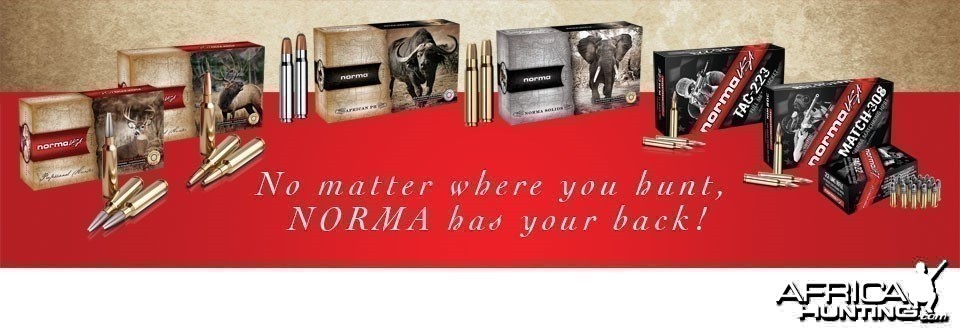USAN
AH fanatic
.505 Gibbs
by Terry Wieland

The .505 Gibbs is an awe-inspiring cartridge that enjoys the unusual distinction of having been undersold and underrated for most of its 90-year history.
Originally known as the .505 Magnum, it was introduced by the Bristol riflemaker, George Gibbs, around 1925 – the exact date is vague – with the goal of replicating .500 Nitro Express stopping power in a bolt-action rifle. The large, roomy case was tailored to the oversized Magnum Mauser action.
The Gibbs is often compared, to its disadvantage, to the .500 Jeffery. The Jeffery does shade it ballistically, at least on paper, with a 535-grain bullet at 2400 feet per second for energy at the muzzle of 6800 ft. lbs., while the 525-grain Gibbs, at 2300 fps, delivers 6190 ft. lbs.
Although the ballistics are similar, the two cartridges are distinctly different. The Jeffery was designed by August Schuler expressly to pack as much power as possible into a standard (i.e., military) Mauser 98 in the years after 1918, when surplus military actions were all that was available. It is extremely compact, with a very short neck, and delivers its numbers at higher pressures.
The Gibbs cartridge, by contrast, is luxuriously large, allowing maximum performance at mild pressures. Anyone with access to a magnum Mauser action, whether from Oberndorf, Granite Mountain, or CZ, is better off with the .505 Gibbs because it is considerably more versatile. Its larger case keeps pressures down, its longer neck holds heavier bullets, and longer bullets do not encroach on powder capacity.
From the beginning, the Gibbs was loaded with a .505 diameter, 525-grain bullet. Since all other .500s, including the .500 Jeffery, use a .510 diameter bullet, its odd size worked against it. For most of its life, .505 diameter bullets were rare. And, at 525 grains, the bullet is decidedly light for its diameter. The standard weight in the .500 NE is 570 grains. A heavier bullet offers two advantages: Its greater sectional density gives better long-range performance, and also better penetration. The first is hardly an issue with the .505 Gibbs, since it is an elephant-and-buffalo cartridge intended for use at relatively short ranges, but greater penetration certainly is.
Like most cartridges in its class, the .505 Gibbs is usually used with solids, but softs have their uses, such as hunting Cape buffalo in herds. With its generous case capacity and long neck, optimum bullet weight for the .505 is 600 grains. Woodleigh did the cartridge a great service when it began producing 600-grain .505-diameter bullets, and Norma did an equally great service for hunters when it elected to load the heavy Woodleighs in its African PH ammunition.
Today, Norma offers several different loads for the .505 Gibbs, from a 540-grain, unimetal solid in the “Professional Guide” line, to a 570-grain soft and two 600-grain loads. The 570 is a Woodleigh conventional soft point, while the 600 is offered in the “protected point” soft and Woodleigh lead-core solid. This may seem like an embarassment of riches, but it offers the elephant and buffalo hunter a load for every situation. In some areas, Cape buffalo are found in herds, and the hunter needs to guard against over-penetration – shooting through an animal and wounding another.
For this reason, some guides insist on soft points for everyday use, with a supply of solids for dealing with wounded animals. Others ask their clients to load only with solids. Norma .505 Gibbs ammunition is available for every situation. With softs, it can be used on smaller animals, such as lions, with gratifying finality.
In the 1930s, Abercrombie & Fitch, in New York, imported .505 Gibbs rifles and ammunition, and clients could test-fire them in the basement shooting range on Madison Avenue. One who did was Ernest Hemingway, who was so impressed that in The Short Happy Life of Francis Macomber he armed his fictional white hunter, Robert Wilson, with a .505 Gibbs. Wilson called it “this damned cannon,” and used it to great effect.
Others who shot the Gibbs in those years complained of the recoil, and there were even tales of broken collarbones and dislocated shoulders. In a suitably heavy rifle, however –ten pounds minimum, and eleven is better – the .505 Gibbs is quite a pleasant rifle to shoot. Comforting, almost, like the overstated affection of a St. Bernard. And comforting, too, when you are going into the bush after a wounded buff.

Terry Wieland has been Shooting Editor of Gray’s Sporting Journal since 1993. He is an award-winning writer specializing in fine firearms, and author of books on wingshooting, big-game hunting, shotguns, and rifles.
Wieland received the Leupold Writer of the Year Award in 1999, the John T. Amber Literary Award from Gun Digest in 2007, and was Zeiss Writer of the Year for 2009.
Wieland’s books include Dangerous-Game Rifles (1st Ed., 2006; 2nd Ed. 2009), Vintage British Shotguns (2008); Spanish Best: The Fine Shotguns of Spain (1st Ed., 1994; 2nd Ed. 2002), A View From A Tall Hill – Robert Ruark in Africa (2000), The Magic of Big Game (1998), and Spiral-Horn Dreams (1995).

by Terry Wieland
The .505 Gibbs is an awe-inspiring cartridge that enjoys the unusual distinction of having been undersold and underrated for most of its 90-year history.
Originally known as the .505 Magnum, it was introduced by the Bristol riflemaker, George Gibbs, around 1925 – the exact date is vague – with the goal of replicating .500 Nitro Express stopping power in a bolt-action rifle. The large, roomy case was tailored to the oversized Magnum Mauser action.
The Gibbs is often compared, to its disadvantage, to the .500 Jeffery. The Jeffery does shade it ballistically, at least on paper, with a 535-grain bullet at 2400 feet per second for energy at the muzzle of 6800 ft. lbs., while the 525-grain Gibbs, at 2300 fps, delivers 6190 ft. lbs.
Although the ballistics are similar, the two cartridges are distinctly different. The Jeffery was designed by August Schuler expressly to pack as much power as possible into a standard (i.e., military) Mauser 98 in the years after 1918, when surplus military actions were all that was available. It is extremely compact, with a very short neck, and delivers its numbers at higher pressures.
The Gibbs cartridge, by contrast, is luxuriously large, allowing maximum performance at mild pressures. Anyone with access to a magnum Mauser action, whether from Oberndorf, Granite Mountain, or CZ, is better off with the .505 Gibbs because it is considerably more versatile. Its larger case keeps pressures down, its longer neck holds heavier bullets, and longer bullets do not encroach on powder capacity.
From the beginning, the Gibbs was loaded with a .505 diameter, 525-grain bullet. Since all other .500s, including the .500 Jeffery, use a .510 diameter bullet, its odd size worked against it. For most of its life, .505 diameter bullets were rare. And, at 525 grains, the bullet is decidedly light for its diameter. The standard weight in the .500 NE is 570 grains. A heavier bullet offers two advantages: Its greater sectional density gives better long-range performance, and also better penetration. The first is hardly an issue with the .505 Gibbs, since it is an elephant-and-buffalo cartridge intended for use at relatively short ranges, but greater penetration certainly is.
Like most cartridges in its class, the .505 Gibbs is usually used with solids, but softs have their uses, such as hunting Cape buffalo in herds. With its generous case capacity and long neck, optimum bullet weight for the .505 is 600 grains. Woodleigh did the cartridge a great service when it began producing 600-grain .505-diameter bullets, and Norma did an equally great service for hunters when it elected to load the heavy Woodleighs in its African PH ammunition.
Today, Norma offers several different loads for the .505 Gibbs, from a 540-grain, unimetal solid in the “Professional Guide” line, to a 570-grain soft and two 600-grain loads. The 570 is a Woodleigh conventional soft point, while the 600 is offered in the “protected point” soft and Woodleigh lead-core solid. This may seem like an embarassment of riches, but it offers the elephant and buffalo hunter a load for every situation. In some areas, Cape buffalo are found in herds, and the hunter needs to guard against over-penetration – shooting through an animal and wounding another.
For this reason, some guides insist on soft points for everyday use, with a supply of solids for dealing with wounded animals. Others ask their clients to load only with solids. Norma .505 Gibbs ammunition is available for every situation. With softs, it can be used on smaller animals, such as lions, with gratifying finality.
In the 1930s, Abercrombie & Fitch, in New York, imported .505 Gibbs rifles and ammunition, and clients could test-fire them in the basement shooting range on Madison Avenue. One who did was Ernest Hemingway, who was so impressed that in The Short Happy Life of Francis Macomber he armed his fictional white hunter, Robert Wilson, with a .505 Gibbs. Wilson called it “this damned cannon,” and used it to great effect.
Others who shot the Gibbs in those years complained of the recoil, and there were even tales of broken collarbones and dislocated shoulders. In a suitably heavy rifle, however –ten pounds minimum, and eleven is better – the .505 Gibbs is quite a pleasant rifle to shoot. Comforting, almost, like the overstated affection of a St. Bernard. And comforting, too, when you are going into the bush after a wounded buff.
Terry Wieland has been Shooting Editor of Gray’s Sporting Journal since 1993. He is an award-winning writer specializing in fine firearms, and author of books on wingshooting, big-game hunting, shotguns, and rifles.
Wieland received the Leupold Writer of the Year Award in 1999, the John T. Amber Literary Award from Gun Digest in 2007, and was Zeiss Writer of the Year for 2009.
Wieland’s books include Dangerous-Game Rifles (1st Ed., 2006; 2nd Ed. 2009), Vintage British Shotguns (2008); Spanish Best: The Fine Shotguns of Spain (1st Ed., 1994; 2nd Ed. 2002), A View From A Tall Hill – Robert Ruark in Africa (2000), The Magic of Big Game (1998), and Spiral-Horn Dreams (1995).
Last edited by a moderator:

